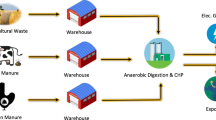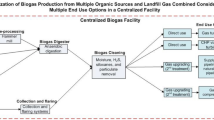Abstract
Biogas from anaerobic digestion of biomass is one of the potential renewable energy sources been considered for adoption in sub-Saharan Africa. Unfortunately, the issue of sustainability of feedstock supply in the biomass to biogas conversion system has been reported as one of the major factors militating against the adoption. Sometimes this challenge of not being able to meet feedstock demand is discovered during the production stage, as most designs reviewed did not incorporate a plan for sustainable supply of feedstock. Considering the enormous resources involved in the development of a bio-digester, it is, therefore, expedient to implement robust model(s) at the design stage, such that it can ascertain sustainability of continuous biomass supply necessary for meeting the biogas demand for all the specified periods. The concept of bio-mimicry with a focus on predator-prey interaction was adopted in developing an inventory-based model that enables the designers of the system to ascertain the critical start-up inventory of the prey(biomass) that will ensure sustained biogas production (predator existence) based on known demand level. The developed model was found useful in determining the minimum start-up biomass prior to production and in determining the level of sustainability for any given start-up inventory. It also provided the basis for decision-making in the commencement of biogas production from a given feedstock source.




Similar content being viewed by others
References
Hassan A, Rahman S, Tasneem F, Bin M, Zawad M (2012) Electricity challenge for sustainable future in Bangladesh. APCBEE Procedia 1:346–350
Oyedepo SO (2014) Towards achieving energy for sustainable development in Nigeria. Renew Sust Energ Rev 34:255–272. https://doi.org/10.1016/j.rser.2014.03.019
Pathak S (2014) Energy crisis: a review. Int J Eng Res Appl 4(3):845–851 www.ijera.com ISSN : 2248–9622
Bacenetti J, Baboun SH, Demery F, Aburdeineh I, Fiala M (2016) Environmental impact assessment of electricity generation from biogas in Palestine. Environ Eng Manag J 15(9):1915–1922 http://omicron.ch.tuiasi.ro/EEMJ/
Gaete-morales C, Gallego-schmid A, Stamford L, Azapagic A (2018) Assessing the environmental sustainability of electricity generation in Chile. Sci Total Environ 636:1155–1170. https://doi.org/10.1016/j.scitotenv.2018.04.346
Yousuf A, Khan MR, Wahid ZA, Pirozzi D, Rahmaddulla SRB (2017) Business models for sustainability of biogas technology. Soc Sci 12(4):609–616
Yazan DM, Cafagna D, Fraccascia L, Mes M, Pontrandolfo P, Zijm H (2018) Economic sustainability of biogas production from animal manure: a regional circular economy model. Manag Res Rev 41:605–624. https://doi.org/10.1108/MRR-02-2018-0053
Okwu MO, Otanocha O, Balogun P, Otega O (2018) Comparative performance of load bearing characteristics of biogas and gasoline fueled electric generator. Int J Ambient Energy 41:1377–1386. https://doi.org/10.1080/01430750.2018.1517669
Okwu MO, David S, Otanocha O, Balogun P, Otega O, Ojo E (2020) Design and development of a bio-digester for production of biogas from dual waste. World J Eng 17:247–260. https://doi.org/10.1108/WJE-07-2018-0249
Haque I, Rozakis S, Ganko E, Kallivroussis L (2009) Bio-energy production in the sugar industry: an integrated modeling approach. A Paper prepared for presentation at the 113th EAAE Seminar “A resilient European food industry and food chain in a challenging world”, Chania, Crete, Greece, September 3–6
Subramani T, Nallathambi M (2012) Mathematical model for commercial production of bio-gas from sewage water and kitchen waste. Int J Mod Eng Res 2(4):1588–1595
Simonyan KJ, Fasina O (2013) Biomass resources and bioenergy potentials in Nigeria. Afr J Agric Res 8(40):4975–4989. https://doi.org/10.5897/AJAR2013.6726
Dinova N, Belouhova M, Schneider I, Rangelov J, Topalova Y (2018) Control of biogas production process by enzymatic and fluorescent image analysis. Biotechnol Biotechnol Equip:1–10
Fagundes DS, Junior MAPO, Orrico ACA, Seno LO (2015) Mathematical models of anaerobic digestion for treatment of swine effluents. Pesq Agropec Trop Goiania 45(2):172–179
Ojolo SJ, Bamgboye AI, Ogunsina B, Oke SA (2008) Analytical approach for predicting biogas generation in a municipal solid waste anaerobic digester. Iran J Environ Health Sci Eng 5(3):179–186
Kana EBG, Oloke JK, Lateef A, Adesiyan MO (2012) Modeling and optimization of biogas production on saw dust and other co-substrates using artificial neural network and genetic algorithm. Renew Energy 46:276–281 www.elsevier.com/locate/renene
Kiely G, Tayfur G, Dolan C, Tanji K (1997) Physical and mathematical modelling of anaerobic digestion of organic wastes. Water Res 31(3):534–540. https://doi.org/10.1016/S0043-1354(96)00175-3
Igoni AH, Sepiribo Iand Harry K (2016) Modelling design of anaerobic continuous digesters for municipal solid waste in biogas production. Int J Chem Environ Eng 7(3):130–140
Ali A, Rundong L, Shah F, Mahar RB, WajidIjaz M, Sallahuddin, Muqueet M (2016) Predictive modeling of biogas production from anaerobic digestion of mixed kitchen waste at mesophilic temperature. Int J Waste Resour 6(3):1–4
Gaur RZ, Suthar S (2017) Anaerobic digestion of activated sludge, anaerobic granular sludge and cow dung with food waste for enhanced methane production. J Clean Prod 164:557–566
Salam B, Biswas S, Rabbi MS (2015) Biogas from mesophilic anaerobic digestion of cow dung using silica gel as catalyst. Procedia Eng 105:652–657
Zareei S, Khodaei J (2017) Modeling and optimization of biogas production from cow manure and maize straw using an adaptive neuro-fuzzy inference system. Renew Energy 114:423–427 26
Safari M, Abdi R, Adl M, Kafashan J (2018) Optimization of bio gas productivity in lab-scale by response surface methodology. Renew Energy 118:368–375 27
Kainthola J, Kalamdhad AS, Goud VV (2020) Optimization of process parameters for accelerated methane yield from anaerobic co-digestion of rice straw and food waste. Renew Energy 149:1352–1359
Tasnim F, Iqbal SA, Chowdhury AR (2017) Biogas production from anaerobic co-digestion of cow manure with kitchen waste and water hyacinth. Renew Energy 109:434–439
Alfa IM, Dahunsi SO, Iorhemen OT, Okafor CC, Ajayi SA (2014) Comparative evaluation of biogas production from poultry droppings, Cow dung and Lemon grass. Bioresour Technol 157:270–277
Abu-Dahrieh JK, Orozco A, Ahmad M and Rooney D (2011) The potential for biogas production from grass. In: Jordan International Energy Conference, Amman, 2011
Tilvikienė V, Venslauskas K, Navickas K, Župerka V, Dabkevičius Z, Kadžiulienė Ž (2012) The biomass and biogas productivity of perennial grasses. Žemdirbystė=Agriculture 99(1):17–22
Sawasdee V, Pisutpaisal N (2014) Feasibility of biogas production from napier grass. Energy Procedia 61:1229–1233
Summoogum-utchanah SL, Poorneema D (2015) An investigation on the potential of biogas production from elephant grass and guinea grass. Am Int J Res Sci Technol Eng Math 9(2):194–197
Dussadee N, Unpaprom Y and Ramaraj R (2016) Grass silage for biogas production. In: da Silva T. and Santos EM (ed) Advances in Silage Production and Utilization. Online:InTech
Boscardo D, Pezzuolo A, Sartori L, Marinello F, Grigolato S, Santacroce C (2017) Grass supply chains for biogas production. Commun Agric Appl Biol Sci 82(4):63–69
Chuanchai A, Ramaraj R (2018) Sustainability assessment of biogas production from buffalo grass and dung: biogas purification and bio-fertilizer, 3. Biotech. 8(151):1–11
Mbachu VM, Igboanugo AC, Alukwe UJ (2019) Development of enhanced substrate from fresh elephant grass for biogas production. Int J Sci Technol Res 8(4):44–49
Mbachu VM, Igboanugo AC, Alukwe UJ, Okwu MO (2021) Enhanced biogas production from fresh elephant grasses, using liquid extract from plantain pseudo stem. Int J Sci Technol Res 10(3):123–127
Debnath KB, Mourshed M, Chew SPK (2015) Modelling and forecasting energy demand in rural households of Bangladesh. Energy Procedia 75:2731–2737
Rennuit C, Sommer SG (2013) Decision support for the construction of farm-scale biogas digesters in developing countries with cold seasons. Energies 6:5314–5332
Author information
Authors and Affiliations
Corresponding authors
Additional information
Publisher’s Note
Springer Nature remains neutral with regard to jurisdictional claims in published maps and institutional affiliations.
Rights and permissions
About this article
Cite this article
Mbachu, V.M., Ovuworie, G.C., Okwu, M.O. et al. Modelling sustainability of a demand-based biomass to biogas conversion system: a bio-mimicry feedstock inventory-based approach. Biomass Conv. Bioref. 13, 4957–4963 (2023). https://doi.org/10.1007/s13399-021-01581-z
Received:
Revised:
Accepted:
Published:
Issue Date:
DOI: https://doi.org/10.1007/s13399-021-01581-z




